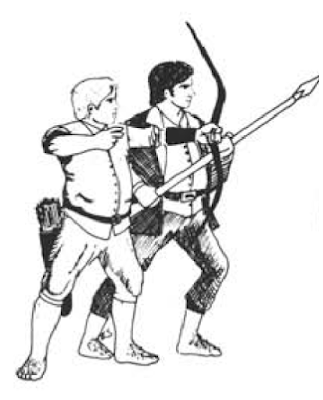While it might not be a good fit for a long-term campaign, there is a type of game in which most of the players agree to play a particular type of character, thus centering the campaign around the type of play optimized for that character. This is most often seen in all-dwarf campaigns, but it could be done with an all-cavalier game (Arthurian myth being the archetype of such a story), an all-ranger game (Robin Hood), and so forth.
It should go without saying that such a game requires the buy-in of all the players in advance.
Such games are quite possible in the World of Greyhawk as well, and I thought it would be interesting to go through the various possibilities, and where they would best fit into the setting.
One thing I think is important to note, however, is that such games work best when there is one character in the party that bucks the trend. Like Merlin among the Knights of the Round Table, or Friar Tuck amidst Robin Hood’s Merry Men, having a single counter-example lends a lot of depth to such a game, and affords opportunities for the game to avoid dullness and repetitiveness, as alternate solutions to class-and-race focused problems present themselves. Care must be taken with such characters, however; the player must be willing not to hog the spotlight, and should realize that his is the role of sidekick, albeit one who might often save the day through means the rest of the party finds unconventional.
I’m using the 1E AD&D rules for my suggestions below (and using CY 576 as my default date), but the principle could be applied to any version of the game or published era of the setting.
First, the class-based game.
Barbarians: An all-barbarian campaign can be a hoot. Freed from the constraints of civilization, even a good-aligned group of barbarians can have all manner of shenanigans as they encounter the baffling ways of civilized folk. The obvious choices are the Suel barbarians of the Thillronian Peninsula, but barbarians can be found in various places in the Flaness, such as the larger woodlands, the Rovers of the Barrens, Wolf or Tiger nomads, etc. As a counter-point, a magic-user is the obvious choice if the rest of the party is of sufficiently high level to tolerate such things, but a well-meaning cleric (perhaps a missionary from civilization come to bring the Good Word to the benighted barbarians) would work quite well.
Cavaliers/Paladins: This is one of the easiest types of themed games to contemplate in the Flanaess. Nations such as Furyondy, Nyrond, the Shield Lands, Veluna, and Almor all present high-feudal environments where knights and squires would find much opportunity for action and adventure. Even if one places a game post-Wars, the Knights of Holy Shielding afford an excellent opportunity for character development as the knights-in-exile attempting to regain their former homeland. Even the Great Kingdom would work for such a game, and could even play off of the conflict between the evil of the Malachite Throne and the aspirations of those still-good nobles in the realm. As a counter-point character, consider a thief or magic-user. The former is constantly putting the chivalric code to the test amongst his comrades, while the latter has such a different approach to problem-solving as to afford great opportunities for role-playing between the characters.
Clerics: An all-cleric game has plenty of choices in the Flanaess, as there are a number of theocratic states that could be used as a backdrop. Almor, Veluna, and the Pale are examples of good-aligned states (dedicated to Rao, Heironeous, and Pholtus, respectively). Medegia is an interesting choice for an evil-aligned game, as Spidasa worships Hextor, but even then some interesting prospects could arise. For a counter-point character, a thief or hard-bitten fighter who is cynical and world-weary might be a good choice.
Druids/Rangers: A game centered on a particular woodland, and protecting it against the threats to that forest, would make a great campaign. The Vesve, Adri, Rieuwood, and Gnarley forests face threats from Iuz, the Great Kingdom, South Province, and the resurgent Temple of Elemental Evil (as of CY 576) respectively. Other threats present themselves as the timeline of the campaign is advanced. A counter-point, any character from a very urban environment (which could be just about any class) would work; thieves and magic-users especially so.
Fighters: Imagine a mercenary company, traveling from place to place as local wars flare up and the ever-present need for sharp swords is filled. This could be set just about anywhere; while there are numerous large-scale conflicts (in CY 576, the ongoing skirmishing between the Iron League and the Great Kingdom, for instance, and the battles between Furyondy, the Shield Lands, Horned Society, and Iuz), but even within relatively peaceful realms there will be smaller-scale battles between local lords that are often decided by a skirmish or three. A traveling company of Perrenlander mercenaries would be especially on-point. Such a game also gives the DM a perfect opportunity to just point the party somewhere new; that’s where the next job came from. For a counter-point, an idealistic cleric or magic-user would be perfect, thrust into a group of warriors whose outlook on life is totally at odds with his own.
Thieves/Thief-Acrobats/Assassins: Oh, the thieves’ game! Rival guilds, or schisms within guilds, or even just street gangs, or long-established criminal families legitimate businessmen… This could happen anywhere you have a city; Greyhawk, Dyvers, Stoink, Rauxes (what must their thieves guild be like?!?). You could have racially-based guilds at odds with one another (shades of the “halfling thieves guild” from the old Fineous Fingers comic, for those old enough to remember that). Maybe the acrobats want to break away from the regular thieves. There’s lots to work with here. And the counter-point can be just about anything; a hulking barbarian more suited to swordplay from horseback than subtle thievery in alleyways (Fafhrd and the Grey Mouser, or Chert and Gord), magic-users or clerics brought in to support the thieves; fighters brought in as muscle. So much potential with this one.
Then there are the racially-themed campaigns.
Dwarves: The all-dwarf campaign has literary antecedents that go back to The Hobbit, of course. Quintessentially, it is structured around a specific quest. The dwarves could come from the Principality of Ulek, the Iron Hills, Lortmils, or the Flinty Hills. As before, the quintessential counter-point is a halfling, but an elf or half-orc would be an interesting foil for dwarven culture.
Elves: I think a great way to do an all-elf game would be to a quest to discover the secrets of the ancient elder elves; perhaps something connected to the links between the elves and the mysteries they guard. The Spindrift Isles are a natural locale, but an investigation into hidden secrets in the courts of Celene or Ulek would also be a possibility. A good counter-point could be a dwarf (for the more obvious culture-based comedy and critique), but a half-elf could make for a more sophisticated exploration of the place of cross-breeds in elven society.
Gnomes and Halfings: I hate to lump these two into the same category, but to be honest both have a lot of things in common when it comes to an all-race adventuring party. It’s notable that neither have any realms of their own, but are found quietly living in and among different human and demi-human races. An all-gnome or -halfling game could be centered around a particular village, perhaps in the Yatil Mountains, Flinty Hills, Hestmark Highlands, Kron Hills, or Ulek (and of course there are many other realms that have sizeable halfling populations). A game centered around gnomes or halflings could focus on protecting the village against dangers, going on a long journey to another settlement to bring back some vital object, etc. A good counterpoint to the small folk is, naturally, one of the big folk; a human who constantly under-estimates the prowess and resourcefulness of the small folk is a natural.
Half-orcs: This is another place where you could just go with an all-evil campaign and have it set in the Pomarj, or Iuz, or the Bone March, and have the party be a gang of mercenaries or assassins or something. That’s the easy way. You could also do something that explores the role of half-orcs in regular human society, or (perhaps even better) their role in orcish society. Are they outcast, semi-outcast but valued for their skills, outright feared, or respected for their skills? I think the answer might differ depending on the locale; surely the towns of the Wild Coast would accept them for what they are (until Turrosh Mak becomes a threat), and cosmopolitan cities like Greyhawk, Dyvers, and Verbobonc would largely grant them respect for their abilities. But in a more rural setting? They might be feared or even driven out. It could make a fascinating study for those who are inclined to games that explore such things.
Finally, it’s of course possible to combine the class and race idea. A party of all dwarven thieves accompanied by a human cleric is a fun inversion of the classic trope, but you could apply the idea to just about any combination allowed by the rules, mixing and matching some of the ideas above. A party of all elven cavaliers based out of Celene, for instance, would make a remarkable game as they undertake missions through the Suss Forest into the Pomarj, in retributive strikes for incursions into their fair homeland.










I’m fairly certain that it was an invention of the Living Greyhawk era but I love it anyway: apparently, the Sultan of Zeif uses the native Orc population as Jannissary type soldiers and bodyguards. They are given a tremendous amount of authority and ‘speak with the voice of the Sultan’. A half-orc party of Baklunish diplomats in Greyhawk would pretty amazing!
Excellent Post (as always but this one especially got me thinking up ideas for new campaigns)
A friend of mine used to talk about a group he was in where they did TOEE with all the characters suffering from insanity (except, of course, a jester).
On that note I’ve always wanted to run TOEE with a party of paladins from different religions, playing up the fact they’re all paragons of LG dedicated to fighting the temple’s evil, but the differences in their religious beliefs is the real driver for the game’s conflict.
I DM’ed a campaign once where the 5 party members were all paladins. A Bakluni paladin of Al Akbar, an Elf paladin of Corellon, a Dwarf paladin of Moradin and a Oeridian paladin of Heironeous. The players had a good time and they also roleplayed their beliefs where there were at times strife among the party on how to resolve situations.
When I saw Druids/Rangers, the first counterpoint that came to mind was a bard a la Kate Capshaw’s Willie from Indiana Jones and the Temple of Doom coping with bugs and being scared of assorted wildlife.
Oh, the screaming! 😀
Thieves: I ran a short-lived all-thieves campaign several years ago. I had placed Casey Christofferson’s excellent Free City of Eskadia far to the west of the Flanaess. The political intrigue and vying for power by the four families in the city made for a gritty city feel that was easily brought to life. A melee in the marketplace between various factions quickly brings the PCs into the mix without a feel of railroading. And there is plenty of time for events between the set pieces/events of the adventure within that it just feels like a part of the show and not the overarching script that the GM and players must adhere to.
I would love to see a similar thing written for The Free City of Hooraygawk (or Hawkgrey, Falcondun, Falkungray, or some such renaming) by the likes of Mr. Bloch, Mr. Lising, etc.
The thing that immediately comes to mind for me, particularly if you’re using 1E rules, is how exactly most of these parties (aside from an all-cleric one, obviously) would heal from combat, traps and all the other hazards out there. It sounds like most of the parties Mr. Bloch describes would be dependent on NPC clerics for healing…which would in turn be a nice way to soak the party for more and more treasure if they go to the same clerics too often and the latter start raising their prices for spells…